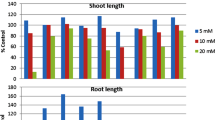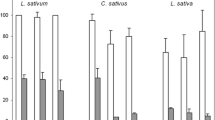Abstract
Low molecular weight phenolic compounds have been identified in fresh leaves and in soils in which leaves of five varieties of Capsicum annuum L. were decomposing. Six phenolic compounds were tested in laboratory bioassays for their allelopathic effects on germination and seedling growth of six weeds. Ferulic acid, gallic acid, p-coumaric acid, p-hydroxybenzoic acid, vanillic acid, and p-vanillin were bioassayed in concentrations of 10, 1, 0.1, and 0.01 mM. Equimolar mixtures containing all these phenolics were prepared at the final total concentration of 10, 1, 0.1, and 0.01 mM to test for possible interactive effects. Chenopodium album L., Plantago lanceolata L., Amaranthus retroflexus L., Solanum nigrum L., Cirsium sp. and Rumex crispus L. were the selected target weeds. The highest concentration of the compounds inhibited the germination of all these weeds, but lower concentrations had no effect or were stimulatory. However, effects varied with the weed species, the concentration of the compound tested and the compound itself. In assays with the mixture of phenolics we found evidence of some additive effects.
Similar content being viewed by others
References
Appel HM (1993) Phenolics in ecological interactions: the importance of oxidation. J Chem Ecol 19: 1521–1552
Blum U and Shafer SR (1988) Microbial populations and phenolic acid in soil. Soil Biol Biochem 20: 793–800
Blum U, Gerig TM and Weed, SB (1989) Effects of mixtures of phenolic acids on leaf area expansion of cucumber seedlings grown in different pH Portsmuth A1 soil materials. J Chem Ecol 15: 2413–2423
Einhellig FA (1986) Mechanisms and modes of action of allelochemicals. In: Putnam AR and Tang CS (eds) The Science of Allelopathy. New York, pp 171–188
Einhellig FA (1987) Interactions among allelochemicals and other stress factors of the plant environment. In: Waller GR (ed) Allelochemicals: Role in Agriculture and Forestry, ACS Symposium Series 330. Washington, DC: American Chemical Society
Einhellig FA and Rasmussen JA (1978) Synergistic inhibitory effects of vanillic and p-hydroxybenzoic acids on radish and grain sorghum. J Chem Ecol 4: 425–436
Gerig TM and Blum U (1991) Effects of mixtures of four phenolic acids on leaf area expansion of cucumber seedlings grown in postsmoth B1 soil materials. J Chem Ecol 17: 29–39
González L, Souto XC and Reigosa MJ (1993) Potential of different pepper cultivars (Capsicum annuum) as weed controllers by allelopathic agents in Galicia (Northwest Spain). In: Proceedings of the 8th EWRS Symposium “Quantitative approaches in weed and herbicide research and their practical application”. Braunschweig, pp 143–150
González L, Souto XC and Reigosa MJ (1995) Allelopathic effects of Acacia melanoxylon R. Br. phyllodes during their decomposition. For Ecol Manag 33: 53–63
González L, Souto XC and Reigosa MJ (1997) Weed control by Capsicum annuum. Allelopathy J 4: 101–110
Inderjit and Dakshini KMM (1995) On laboratory bioassays in allelopathy. Bot Rev 61: 28–44
Klein K and Blum U (1990) Inhibition of cucumber leaf expansion by ferulic acid in split-root experiments. J Chem Ecol 16: 455–463
Kuiters AT and Denneman CAJ (1987) Water-soluble phenolic substances in soils under several coniferous and deciduous tree species. Soil Biol Biochem 19: 765–769
Leather GR and Einhellig FA (1988) Bioassay of naturally occurring allelochemicals for toxicity. J Chem Ecol 14: 1821–1828
Li H-H, Inove M, Nishimura H, Mizutani J and Tsuzuki E (1993) Interactions of trans-cinnamic acid, its related phenolics allelochemicals and abscisic acid in seedling growth and seed germination of lettuce. J Chem Ecol 19: 1775–1787
Lyu SW, Blum U, Gerig TM and O+Brien TE (1990) Effects of mixtures of phenolic acids on phosphorus uptake by cucumber seedlings. J Chem Ecol 16: 2559–2567
Rabotnov, TA (1974) On the allelopathy in the phytocenoses. Izo Akad Nauk SSSR Ser Biol 6: 811–820
Rasmussen JA and Einhellig FA (1997) Synergistic effects of p-coumaric and ferulic acids on germination and growth of sorghum. J Chem Ecol 3: 197–205
Reigosa MJ, Souto XC and González L (1996) Allelopathic research: methodological, ecological and evolutionary aspects. In: Narwal SS and Tauro P (eds) Allelopathy: Field Observations and Methodology. Jodhpur: Scientific Publishers, pp 213–231
Rice EL (1984) Allelopathy. New York: Academic Press
Rizvi SJH and Rizvi V (1992) Allelopathy. Basic and Applied Aspects. London, UK: Chapman & Hall
Souto SC, González L and Reigosa MJ (1994) Comparative analysis of allelopathic effects produced by four forestry species during decomposition process in their soils in Galicia (NW Spain). J Chem Ecol 20: 3005–3015
Souto XC, González L and Reigosa MJ (1995) Allelopathy in forest environment in Galicia, NW Spain. Allelopathy J 2: 67–78
Turner JA and Rice EL (1975) Microbial decomposition of ferulic acid in soil. J Chem Ecol 1: 41–58
Whitehead DC, Dibb K and Hartley RD (1981) Extractant pH and the release of phenolic compounds from soils, plant roots and leaf litter. Soil Biol Biochem 13: 343–348
Williamson GB (1990) Allelopathy, Koch's postulates and the neck riddle. In: Grace JB and Tilman D (eds) Perspectives on Plant Competition. San Diego: Academic Press, Inc, pp 143–162
Author information
Authors and Affiliations
Rights and permissions
About this article
Cite this article
Reigosa, M., Souto, X. & Gonz´lez, L. Effect of phenolic compounds on the germination of six weeds species. Plant Growth Regulation 28, 83–88 (1999). https://doi.org/10.1023/A:1006269716762
Issue Date:
DOI: https://doi.org/10.1023/A:1006269716762




